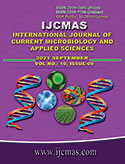


 National Academy of Agricultural Sciences (NAAS)
National Academy of Agricultural Sciences (NAAS)

|
PRINT ISSN : 2319-7692
Online ISSN : 2319-7706 Issues : 12 per year Publisher : Excellent Publishers Email : editorijcmas@gmail.com / submit@ijcmas.com Editor-in-chief: Dr.M.Prakash Index Copernicus ICV 2018: 95.39 NAAS RATING 2020: 5.38 |
An experiment was conducted at Agricultural Research Farm of Brahmanand Post Graduate College, Rath, Hamirpur (U.P.) during 2016-17 and 2019-20 cropping season. In the Bundelkhand agro climatic region seventeen species of insect belonging to seven orders and twelve families were recorded from chickpea agro ecosystem. Among which six species from Lepidoptera, four species from hymenoptera, two species from coleoptera and odonata and one species from hemiptera, isoptera, and dyctyoptera were identified. On the basis of economic importance nine species were insect pests, five species were predators, two species were insect parasitoids and one species was insect pollinator. Among the nine species of insect pests, chickpea pod borer, Helicoverpa armigera Hub. and gram cut worm, Agrotis ipsilon (Huf.) occurred regularly and chickpea pod borer was designated as a major pest while, gram cut worm infested with very low population density and considered as minor insect pest of chickpea. The five species of insect pest occurred occasionally i.e. armyworm, Mythmina separate (walker), tobacco caterpillar, Spodoptera litura (Fab), cow pea aphid, Aphis craccivora (Koch), termite, Odentotermes obesus (Rambur) and black flea beetle, Altica Species (unidentified species) were designated as minor pest of chickpea. While, two species namely, Bihar hairy caterpillar, Spilarctia obliqua (Walker) and beet armyworm, Spodoptera oxiqua (Hub) occurred intermittently in sporadic manner and designated as stray pest of chickpea. The eight species of insect’s ecofriendly fauna inhabiting chickpea agro ecosystem were observed, among which five species of predators, two species of parasitoids and one species of pollinators foraged on chickpea crop occasionally in very low population density. The maximum number of ecofriendly fauna was of the order hymenoptera, two species of parasitoids, one species of predators and pollinator i.e. Trichogrammatid wasp, Trichogramma chilonis (Ishii), ichneumonid wasp, Campoletis chloridae (Uchida), common yellow wasp, Vespa oreintalis (L.) and small honeybee, Apis floraea followed by odonata i.e. dragonfly, Croccothemis servielia (Drury) and damsel fly, Agriocnemis pygmiea (Rambur), coleoptera, rove beetle, Alleochara billienata and dyctyoptera, praying mantis, Mantis religiosa (L.).
 |
 |
 |
 |
 |